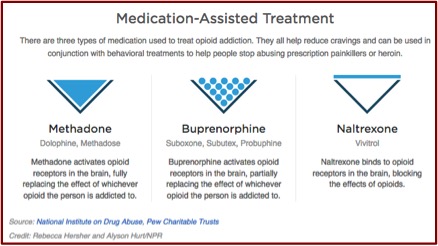Keeping ALKS 5461 Out of the Spotlight?

Alkermes has been stubbornly attempting to gain FDA approval for ALKS 5461 as an adjunctive treatment for major depression. After the FDA informed Alkermes it was refusing to review the NDA (New Drug Application) for ALKS 5461 on March 30, 2018, it rescinded its refuse-to-file letter, and said it would review an NDA for ALKS 5461. The target action date was set for January 31, 2019. The Chief Medical Officer at Alkermes noted there have been no new pharmacological treatment approaches for depression in 30 years and said, “FDA’s filing of the ALKS 5461 application is a positive step forward for patients suffering from major depressive disorder.”
Strategically, at the end of October 2018 Molecular Psychiatry published an article that indicated buprenorphine/samidorphan (ALKS 5461) was “a promising potential adjunctive treatment for patients with MDD.” In one clinical trial, FORWARD-5, adjunctive ALKS 5461 (BUP/SAM 2mg/2mg) consistently reduced depression symptoms compared to placebo across multiple timepoints in patients continuing their current antidepressant therapy (ADT). And it met the primary endpoints of reducing core and overall depression symptoms. In the previous FORWARD-4 clinical trial the primary endpoint of change was not statistically significant; it failed to meet its primary endpoint of change. But in post hoc analysis it did demonstrate greater reduction in MADRS-10 scores than placebo at all timepoints in both stages. “Reductions in symptom scores at multiple timepoints are consistent with the observed efficacy in FORWARD-5.”
This post hoc-analysis was bit like cheating, in that it reanalyzed the data from FORWARD-4 after the fact, and found one aspect of the trial with a significant result. Alkermes used the finding to “update” their methodology for FORWARD-5 to match the post-hoc analysis. It then attempted to argue that despite failing to meet its primary endpoints in the two previous phase III clinical trials, the FDA should approve ALKS 5461. See “The ‘Hotel California’ Effect” and “Nearsighted Drug Development” for more on the problems with this process.
Then on November 1, 2018 the results of the meeting of two combined FDA committees, the Psychopharmacologic Drugs Advisory Committee and the Drug Safety and Risk Management Advisory Committee was released. The Committee voted unfavorably for ALKS 5461. There were three core questions. Has there been substantial evidence presented to support the effectiveness of ALKS for adjunctive treatment of major depression? The vote was against the first question, 20 to 3. The second question was: Has Alkermes adequately characterized the safety profile of ALKS 5461 for adjunctive treatment of major depression? The vote was for the question, 13-10. The third question was also answered negatively, Do the data show a favorable benefit-risk profile of ALKS 5461 to support approval? The vote was against, 21 to 2.
Healio Psychiatry went on to note several concerns of the Committee. The FDA did not agree with Alkermes that the studies met the standard for substantial evidence for effectiveness. Three of the studies used a novel study design: a 2-stage, sequential parallel comparison meant to reduce the higher placebo response often seen in antidepressant studies. This was the first time a sequential parallel comparison design was submitted to the FDA to provide evidence of efficacy for a new drug. “This design has not yet been determined to be statistically acceptable to the FDA.”
Usually studies for antidepressant treatments examine an efficacy endpoint at a specific time point following several weeks of therapy, according to the FDA. These trials achieved primary endpoint because researchers averaged patients’ depression symptoms over multiple weeks, which is not standard for antidepressant trials. Although averaging scores from multiple weeks can reduce the symptom changes that often vary over time throughout treatment, scores at the final time point carry less weight.Although one of the phase 3 studies met its primary endpoint, the committees expressed worry because the trial investigators used an abridged 6-item version of the Montgomery Asberg Depression Rating Scale-10 for the primary endpoint of this principal study. The FDA’s Clinical Outcomes Assessment staff believe MADRS-6 cannot replace the MADRS-10 because it excludes concepts important in major depression, like reduced sleep, reduced appetite, concentration difficulties and suicidal thoughts, according to the review.
So MADRS-6 would not include data on the excluded depressive symptoms such as reduced sleep, and appetite, concentration problems, and significantly, suicidal ideation. Averaging scores would hide a pattern of progressively lower scores throughout the trial, suggesting the antidepressant effect of ALKS 5461 gets weaker over time and will eventually be no better than placebo—not the efficacy pattern to demonstrate when trying to have a NME approved by the FDA. Given the novelty of the methodology used in these clinical trials and the significance of the excluded depression symptoms, the FDA made it clear to Alkermes that any studies using the MADRS-6 would be “considered exploratory.”
The use of an opioid, buprenorphine, was also a concern of the committee. Given the growing opioid epidemic, there were concerns about use, misuse and abuse of buprenorphine. Predicting what might happen in patients being treated for depression is challenging due to the high-risk nature of the populations being treated. “It is not known whether similar misuse and abuse patterns will be seen.”
Finally on February 1, 2019, the FDA said it was not able to approve ALKS 5461 in its present form and requested additional clinical data (likely another clinical trial) to provide substantial evidence for its effectiveness. A review of the Alkermes website on October 12, 2019 failed to see ALKS 5461 listed in its Pipeline under Research and Development. But that doesn’t mean Alkermes has given up on it. There are two active clinical trials for ALKS 5461 listed on Clinical Trials.gov; one of which is recruiting. Its primary outcome measure is a change from baseline in the MADRS scores; the time frame is 11 weeks. The other trial is by invitation, and is a long-term study. The time frame is up to 68 weeks. Both are projected to be completed in 2021 and both have been updated after the FDA sent its complete response letter on February 1st.
It could be that Alkermes terminated these clinical trials after the FDA response letter, but why update the information on ClinicalTrials.gov? If Alkermes is still working on the studies, why does it not have ALKS 5461 listed in its Pipeline? It does not seem that ALKS 5461 is dead yet. One of the studies (clinical trial NCT03188185) apparently plans to use the same parallel assignment method used in FORWARD-4, which the FDA said it had not yet determined was statistically acceptable. The MADRS will be used for its primary and secondary outcome measures, but does not specify whether it will be MADRS-6 or MADRS-10. One of the listed outcome measures is the Columbia Suicide Severity Rating Scale, for suicidal ideation and behavior, but that isn’t necessarily suggestive Alkermes plans to use the MADRS-6.
It is possible that Alkermes is going ahead with a final attempt to gain FDA approval for ALKS 5461, but is trying to keep its efforts quiet and out of the media spotlight. We’ll have to wait and see.






